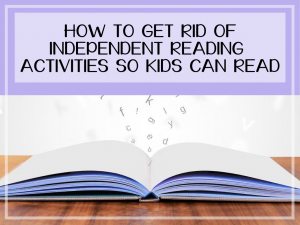You have to work with readers one-on-one. So you need the rest of the kids to be doing something in the meantime. What if they’re just reading? Reading. You don’t have to prep any other independent reading activities. But how in the world do you get them to the point of having reading stamina for 30 minutes?
Train them!
I promise that it’s possible to train your students to read for a sustained amount of time. And today I’m going to show you how.
Why do kids need to have reading stamina?
Reading stamina is a child’s ability to focus and read independently for a sustained amount of time without being distracted or without distracting others.
You want students to have reading stamina for several reasons:
- While kids are reading you can teach or assess other kids either one-on-one or in small groups.
- Kids build stamina which improves fluency which then improves comprehension.
- Because students are reading, you don’t have to come up with activities while you work with other students.
How to Help Kids Reach Reading Stamina
I like to have some type of theme to make practicing reading stamina a little more fun. I’ve done both a Reading Boot Camp and a Superhero Reading Training Camp in my classroom. The steps are the same and the only difference is the theme.
Step #1
You’ll want to create a chart to log how much time your class reads each day. Also, make sure the kids have enough books to read and books they WANT to read. This part is really important in getting kids to buy into reading for a sustained amount of time.
You’ll also want to prepare anything that goes with your theme. I use military I.D. tags when I run a Reading Boot Camp. I use superhero masks when I run a Superhero Training Camp.

Step #2
On the first day of camp, you’ll explain that just like runners practice to race, people need to practice to reach a certain amount of reading time. (You’ll do the amount that you’ll be expecting from your students.)
So for example, on day one will read for 3 minutes. Always start with a very small doable amount even if you think your students can read longer. This sets them up for success.

Step #3
Create an anchor chart of IDR (independent reading) expectations with the students. Ask them to offer suggestions of what they think they should be doing during IDR.
Add any expectations you think they should have but didn’t offer. Some examples are read the whole time, read quietly, and do real reading vs fake reading.

Step #4
Review the IDR expectations and time the kids reading for 3 minutes. If anyone starts to not follow the expectations, start them over for another 3 minutes. Do this as many times as needed.
It may seem tedious but I promise you that the practice will pay off in the end.

Step #5
When 3 minutes is over, celebrate! Tell the class how great they did and that tomorrow their goal will be 5 minutes.
You’ll repeat these same steps each day until your students have reached the amount of reading stamina you expect.
In 3rd grade I like to go up to 30 minutes. This gives me enough time to meet with a couple of small groups or individual students for reading conferences.
At the end of camp, I give the kids a response sheet to fill out about camp. Then I give them a certificate of completion! It’s a great way to celebrate the end of camp.

Frequently Asked Questions
What should I do if only one or two kids have difficulty with the expectations?
Sometimes you’ll have one or two students that are not able to follow the IDR expectations no matter how many times you restart.
If there are only one or two children having difficulty with the training, don’t call them out in front of the class. Just simply tell them privately that they will have to practice during another part of the day as a consequence of not practicing when they were expected to.
This way you can have progress with the rest of the class and that one child isn’t holding the rest of the class back.

What should I do if we come back from a long break and they lose their stamina?
I like to hold camp again after a long school break. It does mean that you’ll have to hold off on teaching reading small groups but the time spent on practicing again will be beneficial.
The second camp of the year shouldn’t take as long to get through. You might start with 5 minutes on the first day back and then add 5 minutes a day until you reach 30 minutes for example. So within a week, you’ll back on track!
What if kids can’t read the books they’re choosing?
Something you can do is have them read picture books. Reading pictures is real reading. Children have to make inferences about what’s happening in the pictures. This is a great way for them to practice while trying to reach reading stamina.
From the very beginning of the year, I teach my students the Spot and Dot method to help them decode big words. This has helped tremendously in developing independent readers. If you’d like a free guide to help you with this, you can sign up at the end of this post.
It will be so worth it!
All the effort you put into training the kids to have reading stamina is going to be worth it for the rest of the year. You’ll be free to work with readers one-on-one or in small groups.
Here’s that guide I was talking about earlier. Using this strategy will transform your students’ ability to read big words! Just click on the picture to sign up and I’ll send it to you!




